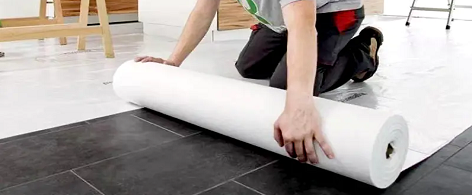Cat:Glue -coated Protective Film
One single flaw is enough to change a “superior” product to “inferior”and thus perfect products need good protection. How you protect your valuable ca...
See Details
Surface protection materials play a vital role in various industries, particularly in transportation, construction, and manufacturing. With the continuous advancement of technology, breathable surface protection felt (BPRF) is gaining increasing attention as a new type of protective material. Compared to traditional plastic films, bubble wrap, and other surface protection materials, BPRF offers many unique advantages.
1. What is Breathable Felt?
Breathable surface protection felt is a highly breathable, soft, and durable material typically made from natural fibers (such as wool, cotton, or other renewable materials) or synthetic fibers (such as polyester). Its key features are:
Breathability: Breathable felt allows air to circulate freely, preventing moisture buildup that can lead to mold, corrosion, and other damage. This airflow protects surfaces from moisture.
Softness: Breathable felt's soft and flexible surface provides a secure barrier against scratches and other mechanical damage on sensitive surfaces (such as delicate wood, metal, or glass).
Environmental friendliness: Many breathable felt materials are made from recyclable natural fibers, making them more environmentally friendly than many traditional plastics.
Durability: Breathable felt typically has a long lifespan and, in many cases, can be reused.
2. Traditional Surface Protection Methods:
Traditional surface protection methods vary, but common ones include:
Plastic film: Commonly used in packaging and shipping, it provides waterproof protection but often fails to effectively control air flow. Oversealing can cause moisture accumulation, which can damage surfaces.
Bubble wrap: Suitable for transporting and storing delicate items, it provides some cushioning. However, it also lacks breathability and cannot effectively prevent surface moisture and mold growth.
Paper or fiber cloth: In some applications, paper protective films or fiber cloth are used to protect surfaces from scratches, but they generally lack breathability and are easily damaged by moisture or oil during use.
While these traditional materials can provide basic physical protection, they often have the following limitations:
Poor breathability: Traditional protective materials are often sealed and cannot effectively withstand humid environments, preventing moisture from evaporating.
Poor reusability: Plastic film and bubble wrap are mostly single-use and must be discarded after use.
Risk of surface damage: Some materials, such as bubble wrap, may scratch or mark surfaces during use, especially on delicate surfaces.

3. Key Differences Between Breathable Felt and Traditional Methods:
Airflow & Moisture Control:
Advantages of Breathable Felt: Breathable felt's greatest strength is its ability to allow air to circulate, effectively preventing surface moisture. Due to its open structure, moisture can evaporate without becoming trapped, preventing mold, corrosion, and other moisture-related damage. Breathable felt performs particularly well in humid environments.
Disadvantages of Traditional Methods: Traditional protective materials such as plastic film and bubble wrap lack breathability, allowing moisture to accumulate, potentially causing corrosion or mold on surfaces, especially within closed packaging or storage spaces.
Surface Safety:
Protective Benefits of Breathable Felt: Breathable felt is soft and flexible, making it very surface-friendly and effectively protecting against scratches, impacts, and other mechanical damage. It provides additional protection when transporting or storing delicate items.
Surface Risks of Traditional Methods: For example, bubble wrap or plastic film can damage surfaces due to uneven contact forces during handling. Additionally, the stickiness or hardness of some traditional materials may leave scratches or marks when removed, especially on delicate surfaces.
Durability & Longevity:
Breathable Felt Durability: Breathable felt is generally very durable and can be reused multiple times, especially those made from natural fibers, which have a long lifespan. Furthermore, breathable felt maintains high stability even in extreme weather conditions.
Replacement Cost of Traditional Methods: Traditional protective materials, such as bubble wrap or plastic film, are typically single-use and must be discarded after use, increasing costs over time.
Environmental Impact:
Breathable Felt Environmental Impact: Many breathable felts are made from renewable materials and are easily recyclable, resulting in a lower environmental impact. They are more environmentally friendly than plastic film and help reduce waste.
Eco-Friendly Issues with Traditional Materials: Plastic film and bubble wrap are often difficult to degrade, and the recycling process is complex, placing a burden on the environment.
4. When to Use Breathable Felt vs. Traditional Protection Methods:
When to Use Breathable Felt:
Long-Term Storage: Breathable felt provides ideal protection for items that need to be stored for long periods of time, especially for sensitive materials that need to remain dry. Delicate items: Breathable felt can effectively prevent surface scratches and deformation, such as artwork, wooden furniture, or high-end electronics.
Outdoor exposure: In construction or outdoor environments, breathable felt effectively protects against moisture and prevents surface damage caused by exposure.
Application scenarios for traditional methods:
Temporary protection: For items used for a short period of time, especially during transportation, traditional materials such as bubble wrap or plastic film may be more practical.
Rough transportation: In situations requiring intensive protection, such as those subjected to rough transportation, traditional protective materials may provide greater impact resistance.
5. Cost Considerations:
Cost of breathable felt: While breathable felt has a higher initial purchase cost, its durability and reusability can significantly reduce long-term costs. Breathable felt is a cost-effective option, especially for applications requiring frequent surface protection.
Cost of traditional methods: While traditional protective materials have a lower initial cost, their single-use nature leads to frequent replacement and additional costs over time.
6. Case Studies:
Construction Industry: In high-end residential and commercial construction projects, breathable felt is widely used to protect floors and walls to prevent moisture accumulation and surface damage. After a single application, the felt can be cleaned and reused.
Art Conservation: Museums and galleries use breathable felt to protect artworks from exposure to harsh environments, maintain ventilation, and prevent moisture, ensuring long-term preservation.
Transportation Industry: Some high-end home appliances and artworks are also beginning to use breathable felt for safer transportation.